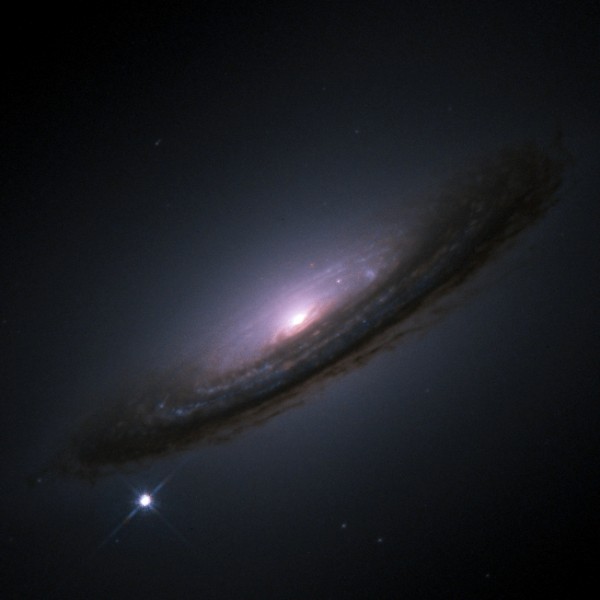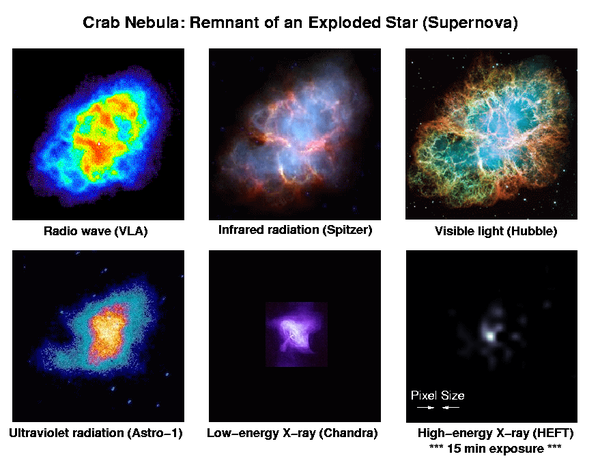The history of supernovae - fireworks of our galaxy!
When I convinced myself that not a single star of this type had shone before, I was so perplexed because of the improbability of the incident that I began to doubt my own eyes.
- Tycho Brahe
When we look at the galaxies scattered throughout the Universe, we see that periodically - about once a century - a bright star inflames so strongly that for some time it can eclipse the rest of the galaxy!

This, of course, does not increase the brightness of the star - it is the very atoms that make up the star, are involved in an uncontrolled nuclear fusion reaction, and lead to the notorious phenomenon called supernova!
')
As part of the largest of the scientific bad luck bands, we have not seen a supernova explosion in our galaxy since the invention of the telescope! The last time she rushed in 1604, and since then has long since disappeared from view. It’s good that we can study these objects not only in visible light: we can deploy a multitude of telescopes sensitive to different wavelengths to those areas of the sky where supernovae were recorded, and see how they look today!

The supernova of 1604 was the last one visible from Earth to the naked eye, and here it is shown using a combination of visible light, X-rays and infrared photography. Due to the absence of a powerful X-ray source (neutron star or black hole) in the center, this explosion was most likely of type Ia, when a white dwarf either merges with another star, or gains enough additional mass, and explodes!
The same thing happened with the previous one, SN 1572 .

Not representing anything special in appearance, the super-hot remnants of an exploding star scattered into space with breathtaking speeds of thousands of kilometers per second, and they were so hot that they emitted x-rays! There is also dust spread throughout the galaxy, and it heats up from a supernova explosion - that’s what glows in the infrared.
Last supernova before that? We'll have to return right up to 1181 , and we are still not sure that we have found her remains. But we definitely found the one we saw before: SN 1054 .

These remnants, as you can see, look completely different from previous ones, and there is a reason for this: it is a completely different type of supernova! The Crab Nebula , also known as Messier 1, was not formed by a too massive white dwarf, but appeared because of a supermassive star that burned all its fuel and died in the collapse of the nucleus, which led to the release of matter on dozens of solar masses!
The collapse of the nucleus of this star has created a pulsar. Pulsars are one of the most amazing clocks of the Universe, only atomic clocks on Earth surpass them in accuracy!
Before that, it was the brightest of all supernovae recorded on Earth in 1006th .

At this point, you should already realize that once it was a white dwarf, and not a supermassive star. After 1000 years, the bubble created by the explosion would have grown to the size of several light years, and if our star had exploded so much, then the edge of the bubble would have been halfway to Alpha Centauri!
Before 1006, there was one explosion in 393, which we may have found, another one in 386 , which seemed to be found, but most likely it was not, and the oldest supernova, from those recorded and confirmed: 185 !

Looking at the X-ray image 2,000 years later, we can say that it was a white dwarf, not a supermassive star.
But considering these images, I thought: how interesting would it be to study these remains only in visible light, as if photos of space fireworks in an accelerated survey? Let's get a look.

After almost 2000 years, the remnants of the supernova RCW 86 (from the 185 year supernova) still have visible outer contour of the bubble in the visible range (red, above). Like the last stage of the firework, this is the last part that will be visible to the human eye (blue is the x-ray gas).
But it turns out that for a thousand years they change little.

Supernova 1006 is barely visible in visible light, only a thin strip and a very dim gas along the outer contour (and of course, all the other stars!) Are visible. But supernova 1054, which we talked about as the remnants of a supermassive star, and not a white dwarf, is a completely different thing.

Remember that magnificent image of the Crab Nebula that I showed you? This is a photo only in visible light! The outer layers of a gas rich in the lightest of the heaviest elements — oxygen, carbon, and nitrogen — create beautiful and contrasting colors in the nebula when they overheat and spray around interstellar space.
But photographs taken at a variety of other wavelengths can tell us much more, as you can see, from bright x-ray sources in the core of stars to the warm dust observed in infrared telescopes. In the case of the Crab Nebula, visible light, however, can tell a lot about it, thanks to the large amount of gas and dust, as well as the energy that has come out with them.
Supernova 1572, which had almost no gas and dust, is another case.

After all, were they supposed to find the remains of a sun-like star blown up by its companion, which turned into a supernova about 500 years ago? Not a trace.
So the options are different, and the supernova of 1604 will be an excellent example.

Neither a strip, nor a bubble, but only a small area where a little luminous gas can be seen from the remains.
What is missing is a snapshot of a supermassive blast, where the hot visible dust has been swept away. What would he look like?
Since 1604, there have been no supernovae in our galaxy visible from Earth with the naked eye. But at the end of the 17th century, one supernova appeared, and although its remains are barely visible in the optical range, it is the loudest radio source in our galaxy: Cassiopeia A!

It is located 11,000 light-years away, its remnant size has already taken 10 light-years across - it has grown more than the Crab Nebula, while growing three times less time! Since this is the strongest radio source, there probably must be some kind of fantastic neutron star or black hole.
But I wanted to show you the fireworks.
The next photo is not a visualization or a simulation. Incomparable telescope them. Hubble made a great long exposure photo that captured visible light from supernova remnants, which you need to look at in order to understand why I call these explosions “cosmic fireworks”.

This is amazing! If you have time, I recommend to play around with a large-scale version of the photo . I decided to show you in parts and comment on the most interesting parts of it.
Turn to the bubble.

Now look at the three-layer structure on top of the bubble. Pay attention to small "columns", some regions in which the density of matter is higher than that of others.

And now we will increase the green area.

Hope you enjoyed the fireworks! Too much time has passed since the appearance of a supernova in our galaxy. Will we see a new one in our lifetime? As the count of Monte Cristo concludes:
All human wisdom is contained in two words: wait and hope.
In the meantime, enjoy the show!
Source: https://habr.com/ru/post/397513/
All Articles